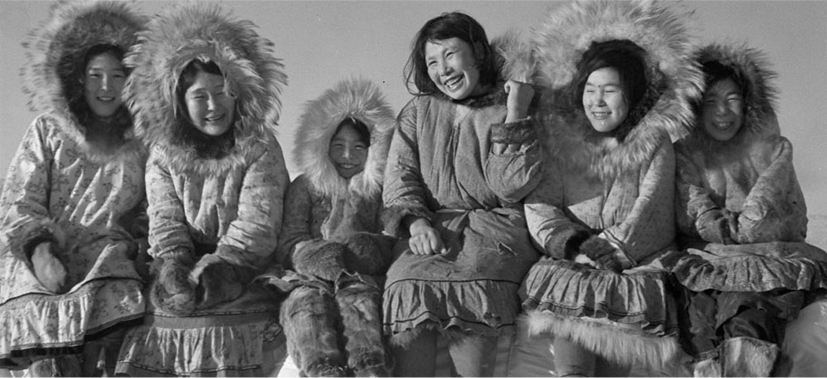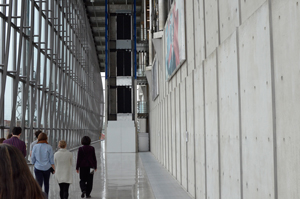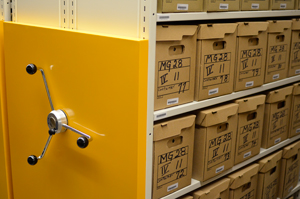


A GALLERY WITHOUT A SPACE:
VIRTUALLY CURATING THE PORTRAIT GALLERY OF CANADABy Michel Hardy-Vallée
Canada has no national portrait gallery, no hallowed hall hosting images of its foremost individuals, nor does it plan to have one. A program rather than a building, an idea rather than a landmark, the Library and Archives Canada Portrait Portal brings together works amassed since the 1880s. A demotic collection of portraits, bringing together both celebrities and people living outside the spotlight, those faces lie in waiting among the fireproof vaults, called up to exhibition by the modest index card or the more modern HTML page. Its existence is never fixed in time or in space, and is only made tangible by the active work of curating.

Students, professor and archivists on their way to concrete vault of the Library and Archives Canada Conservation Centre, 2011
_____________

Archival boxes holding documents, 2011
_____________

View of oil painting holdings, 2011
_____________

Glass housing surrounding the concrete vault of the Library and Archives Canada Conservation Centre, preventing direct exposure of the structure to the elements, 2011
_____________
Photo Credit: Michel Hardy-Vallée (Canadian, 1980–). Digital photograph © 2012 Michel Hardy-Vallée. Courtesy of the artist
Curating is fundamentally an activity grounded in taste; not the classificatory and merely evaluative kind which French sociologist Pierre Bourdieu assailed, but rather the more humanistic kind, which employs the experience and sensibility of the curator as sounding board. In the process of selecting and researching the images of the present website, it is the curators themselves, assisted by the staff at Library and Archives Canada, who had to be probed for navigating the virtually endless amount of images in the digital archive. The resulting crop is a highly original, at times personal set of outlooks on the portraits found in Library and Archives Canada, and what they have to say about this country.
Graduate students of Art History, the curators of this website have worked under the guidance of professor Loren Lerner of Concordia University to produce virtual exhibits of Canadian portraits along a variety of open-ended categories that can address contemporary themes of Canadian identity. Intersecting social history, artistic practices, cultural aspects of representation, the resulting selections interrogate the role of portraiture, a concrete representation, for the nation, an especially abstract entity. Finding grounds for grouping images necessarily forces a questioning of preferences, and a struggle with the ethical implications of portraiture is never far from the concerns of the curators. This is particularly visible in exhibits involving women, immigrants, First Nations, and Inuit people, in that the subjects of these exhibits is not only the people therein, but the process whereby they are imaged and imagined. In addition to producing two distinct virtual exhibitions, each curator wrote in turn an extended essay on a single picture presenting a particular curatorial, historical or theoretical problem, informed by major thinkers within and outside the field of Art History. Finally, collaboration with the students of Concordia Studio Arts professor Marisa Portolese led to the production of short, pointed curatorial texts on photographic portraits by the students, exploring the portrait archive of the times to come.
By examining such rich, contested cultural territories, these exhibits function as experiments in epistemology for the students involved, requiring them to question not just knowledge but its modes of acquisition as well: making links between pictures makes visible the curators’ own worldview at the same time that it brings to the surface sediments of Canadianness. This online reflection on the idea of a nation, like the statutes and laws that hold it together, may not be set in stone and concrete, but it has the virtue of portraying virtually what exists in principles.
Michel Hardy-Vallée, Ph.D. student in Art History at Concordia University
